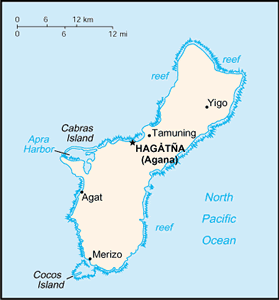The Geography of Guam
The Geography of Guam
Guamanian Geography
Location: Oceania, island in the North Pacific Ocean, about three-quarters of the way from Hawaii to the Philippines
Geographic coordinates: 13 28 N, 144 47 E
Map references: Oceania
Area: total: 541.3 sq km land: 541.3 sq km water: 0 sq km
Area - comparative: three times the size of Washington, DC
Land boundaries: 0 km
Coastline: 125.5 km
Maritime claims: territorial sea: 12 nm exclusive economic zone: 200 nm
Climate: tropical marine; generally warm and humid, moderated by northeast trade winds; dry season (January to June), rainy season (July to December); little seasonal temperature variation
Terrain: volcanic origin, surrounded by coral reefs; relatively flat coralline limestone plateau (source of most fresh water), with steep coastal cliffs and narrow coastal plains in north, low hills in center, mountains in south
Elevation extremes: lowest point: Pacific Ocean 0 m highest point: Mount Lamlam 406 m
Natural resources: aquatic wildlife (supporting tourism), fishing (largely undeveloped)
Land use: arable land: 3.64% permanent crops: 18.18% other: 78.18% (2005)
Irrigated land: NA
Natural hazards: frequent squalls during rainy season; relatively rare, but potentially very destructive typhoons (June - December)
Environment - current issues: extirpation of native bird population by the rapid proliferation of the brown tree snake, an exotic, invasive species
Environment - international agreements:
Geography - note: largest and southernmost island in the Mariana Islands archipelago; strategic location in western North Pacific Ocean


